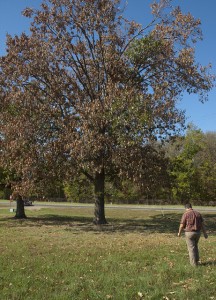by Mark Chisholm, Certified Arborist
As a third-generation arborist and three-time world tree-climbing champion, I’ve learned firsthand that trees are much more vulnerable than we assume. A tree might seem like it would be able to sustain the forces of a large storm, but sometimes internal damage is just too difficult to see. Ultimately, you want to be prepared before, during and after any storm – big or small.
 Here are my Top Ten Tips for Weathering Storm Season:
Here are my Top Ten Tips for Weathering Storm Season:
Before the storm:
-
Develop a relationship with a certified arborist or tree care professional.
This will give you time to pick and choose the right company in your area. When a storm hits, you’ll likely be prioritized as an existing customer. Here are 10 questions you should ask when interviewing tree service companies.
-
Conduct a pre-storm assessment. Identify trouble spots before a storm hits.
Some potential hazards to look for on your property:- Cracks in tree trunks or major limbs
- Hollow, aged and decayed trees
- One-sided or significantly leaning trees
- Branches leaning more than 45 degrees over the roof
- Anything in close proximity to utility lines
- Shelf-like fungus or mushrooms
- Trees with dangerous leans
*Note: Several of these features may suggest that the tree may be suffering from a condition called heart rot or possibly buckling under its own weight, and causing danger.
-
Take measures to prevent damage.
After assessing possible hazards to your property, you and/or your arborist may need to take any number of measures to limit potential damage.- Remove dead, diseased or damaged limbs
- Have leaning trees inspected and consider removing those with large cavities
- Prune branches too close to your house and over the street
- Check your gutters, and remove debris to prevent water damage. Many STIHL blowers can use optional gutter attachments.
- Call a professional to assess and potentially remove any within close proximity to utility lines; DO NOT attempt to do this yourself
During the storm:
-
Don’t try to be a hero.
Your property is not more important than your life and the lives of your loved ones. Prepare in advance, follow guidelines for evacuations, and don’t hesitate to get assistance.
After The Storm:
-
Put safety first.
It’s important to protect yourself as well as your property.- Be on the alert. Stay away from utility lines and keep an eye out for dangers both up in hanging branches and down on damaged trunks.
- Broken limbs may still be lodged in trees, but can easily and unexpectedly fall. Loggers call these “widow-makers.”
- Look for trees leaning against or touching downed phone lines or power lines – a tree in contact with a power line, and the ground at the base of the tree, can be energized and dangerous.
- When in doubt, call your arborist (See #8 below)
- If you’re skilled enough to do work yourself, suit up properly, wear the proper attire and protective equipment. Many times we see newscasts of people wearing shorts and flip-flops to clean up storm damage. This is not what you should be wearing to do this type of work.
- Follow the guidelines in your instruction manual for any power equipment you’re using.
-
Evaluate tree damage.
Evaluate your trees carefully by asking the following:-
- Other than storm damage, is the tree basically healthy?
- Are major limbs and/or the leader branch still remaining?
- Is at least 50 percent of the tree’s crown still intact?
- Are there remaining branches that can form a new branch structure?
If you answer “yes” to the majority of these questions, there is a good chance the tree can be saved. When in doubt, consult a professional.
-
-
Take Steps to Repair Minor Damage & Debris.
- Remove any broken branches or stubs still attached to the tree.
- Remove jagged remains of limbs to reduce the risk of decay agents entering the wound.
- Smaller branches should be pruned at the point where they join larger ones.
- Resist the urge to over-prune. Don’t worry if the tree’s appearance is not perfect.
-
Do not try to do it all yourself.
Evaluate what you can handle and what’s for a pro – anything not on the ground should definitely be handled by a professional. Some of these things could be a threat to your life, so it makes sense to spend the money if you’re not absolutely confident in your skills or if any of the below situations apply:- Large limbs are broken or hanging or overhead chainsaw work is needed.
- If a tree is uprooted or downed, it can create an unnatural pattern of pressure points and tension. A chainsaw operator may be in severe danger if attempting to cut a tensioned limb or trunk (called a “springpole”) – it may have an extremely violent, catapult-like reaction.
- If branches are too close or touching utility lines, report immediately to your local utility company. NEVER attempt to move downed utility lines.
- Any task you have not been properly trained to handle or are uncomfortable undertaking.
-
Consider wildlife.
Birds or bees may have been taking temporary storm shelter while you are doing work – always proceed with caution.
-
Stay educated.
Learn more tips on tree safety, chainsaw safety, finding a tree care professional, and how to prepare for storms at the following websites: